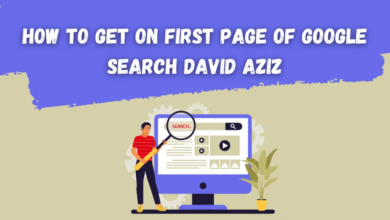How to Get on the First Page of Google Search: Insights from David Aziz

Getting on the first page of Google is a vital goal for businesses, bloggers, and anyone wanting visibility online. With over 5.6 billion searches happening each day, the first page of Google holds immense value.First Page of Google Search The difference between being on the first page and on the second is often night and day—most users rarely click past the first page. This article explores strategies and insights to help you rank on Google, drawing on industry knowledge and expert advice from digital marketing professionals like David Aziz.
Who Is David Aziz?
David Aziz is a prominent figure in the world of search engine optimization (SEO) and digital marketing. Known for his innovative approaches and deep understanding of Google’s ever-changing algorithms, Aziz has helped many businesses rank higher on search engines. His advice is often sought after by entrepreneurs, small businesses, and large corporations alike for creating effective SEO strategies. In this guide, we’ll incorporate some of his core strategies and proven techniques that can significantly boost your chances of getting on that coveted first page of Google.
1. Understanding Google’s Search Algorithm
Before diving into specific strategies, it’s important to understand the basics of Google’s search algorithm. Google uses a complex system to evaluate web pages and determine their relevance to specific queries. While the exact workings of the algorithm are proprietary, Google has revealed several key ranking factors that play a crucial role in determining search results.
Some of the primary ranking factors include:
- Content Quality: High-quality, relevant content is crucial. Google wants to deliver the most valuable information to its users.
- Keywords: Google analyzes the use of relevant keywords within the content.
- Backlinks: The number and quality of links pointing to your site from other reputable websites influence ranking.
- User Experience: A site that offers a good user experience, including fast loading speeds and mobile-friendliness, performs better.
- Domain Authority: The authority of your domain in your niche or industry is a significant factor.
- Engagement Metrics: Metrics like bounce rate, time on page, and click-through rate (CTR) indicate how users engage with your content.
Understanding these factors will help you craft a comprehensive SEO strategy that increases your chances of ranking higher on Google’s first page.
2. Keyword Research and Strategy
One of the fundamental techniques in SEO, championed by David Aziz, is keyword research. Keywords are the words and phrases people type into Google to find the information they’re looking for. Ranking for the right keywords can make or break your chances of getting on the first page.
Find the Right Keywords
Here’s how to approach keyword research:
- Use Tools: Tools like Google Keyword Planner, Ahrefs, or SEMrush can help you find relevant keywords and estimate the search volume for each one.
- Look for Long-Tail Keywords: Long-tail keywords (i.e., phrases with three or more words) are often easier to rank for and bring more targeted traffic. For example, instead of targeting “shoes,” target “best running shoes for flat feet.”
- Focus on Intent: Google increasingly focuses on search intent—whether a user is looking to learn something (informational intent), buy something (transactional intent), or find a specific site (navigational intent). Tailoring content to match the search intent of your audience is key.
Optimize Your Content for Keywords
Once you’ve identified the right keywords, you need to incorporate them naturally into your content. Overstuffing content with keywords can lead to penalties from Google, so it’s essential to maintain a natural flow. Place the primary keyword in the title, meta description, headings, and throughout the body of your article in a way that feels organic.
David Aziz emphasizes the importance of balancing keyword optimization with readability. Google’s algorithm is advanced enough to understand the context, so focusing on user experience while incorporating keywords is a winning approach.
3. Content Is King: Create High-Quality, Valuable Content
According to David Aziz, content is one of the most important factors in SEO success. Google prioritizes content that is informative, well-researched, and valuable to users. Here’s how you can create content that stands out:
Answer the User’s Query
Every time someone searches on Google, they’re asking a question, whether explicitly or implicitly. Your content needs to provide a comprehensive, relevant answer to that question.
- Focus on Detailed Guides and How-To Articles: These types of content tend to rank well because they answer user queries comprehensively.
- Use Visuals: Incorporate images, infographics, and videos to make the content more engaging.
- Update Regularly: Google loves fresh content. Regularly updating old articles or creating new content on trending topics in your niche will improve your rankings.
Utilize the E-A-T Principle
Google’s quality evaluators follow the E-A-T principle—Expertise, Authoritativeness, and Trustworthiness—to determine which content is most deserving of a top spot.
- Expertise: Write content that reflects your deep knowledge of the subject.
- Authoritativeness: Make sure your site or content is seen as an authority in your field. You can build authority by obtaining backlinks from reputable sites.
- Trustworthiness: Use secure HTTPS connections, provide accurate information, and build a professional online presence.
Aziz recommends focusing heavily on building E-A-T through collaboration with authoritative voices in your niche, guest blogging, and consistently publishing well-researched, data-backed content.
4. On-Page SEO Optimization
On-page SEO refers to the practice of optimizing individual pages to rank higher in search results. David Aziz stresses that the smallest tweaks can lead to significant improvements in rankings.
Title Tags and Meta Descriptions
Your title tag and meta description are often the first things users see in Google search results. A well-written title and description that incorporate your target keyword can improve your click-through rate (CTR) and ultimately boost your ranking.
- Title Tags: Include your primary keyword and keep the title under 60 characters. Make it compelling enough for users to want to click.
- Meta Descriptions: Write a clear, concise meta description (up to 155 characters) that summarizes your content and encourages users to click. Including your primary keyword here is a good practice.
Header Tags (H1, H2, H3)
Use header tags to structure your content logically. The H1 tag should contain your main keyword, while H2 and H3 tags should be used to break the content into subtopics. This helps both users and Google’s crawlers understand the structure of your article.
Internal Linking
Linking to other relevant pages on your site (internal linking) can help Google understand the context of your content. It also helps distribute page authority across your site.
5. Backlinks: Building Authority
Backlinks—links from other websites pointing to your site—are one of the most powerful ranking factors. Google sees backlinks as votes of confidence from other sites, signaling that your content is valuable and trustworthy.
How to Get Quality Backlinks
David Aziz emphasizes the importance of acquiring high-quality backlinks from authoritative sites in your industry. Here are some strategies for obtaining backlinks:
- Guest Blogging: Write valuable content for other reputable websites in your niche. In return, you can usually include a backlink to your own site.
- Create Shareable Content: High-quality content like infographics, case studies, and comprehensive guides is more likely to be shared and linked to.
- Outreach: Reach out to influencers and websites in your industry to let them know about your content. If they find it valuable, they might link back to it.
Not all backlinks are created equal. Links from spammy or irrelevant websites can actually hurt your rankings, so focus on building relationships with reputable sites in your niche.
6. Technical SEO
In addition to content and backlinks, you need to make sure that Google can crawl and index your site properly. This is where technical SEO comes in. Some key technical SEO elements include:
- Site Speed: Ensure your site loads quickly. Google uses site speed as a ranking factor, so optimizing images, enabling browser caching, and using a Content Delivery Network (CDN) can help improve speed.
- Mobile-Friendliness: With Google’s mobile-first indexing, your site needs to be optimized for mobile devices. Use responsive design to ensure that your site looks and functions well on all screen sizes.
- XML Sitemap: Create an XML sitemap and submit it to Google to help the search engine crawl and index your site effectively.
- Secure Website (HTTPS): Using HTTPS is a ranking factor. Ensure your site has an SSL certificate to keep it secure.
7. Monitoring and Adjusting Your SEO Strategy
SEO is not a one-time effort. It requires constant monitoring and adjustment to keep up with Google’s algorithm updates and changing trends. Use tools like Google Analytics and Google Search Console to track your progress, analyze traffic data, and identify areas for improvement.
David Aziz often highlights the importance of being agile and responsive in your SEO efforts. Regularly audit your site, track the performance of your content, and adapt to new SEO trends and updates.
Conclusion
Getting on the first page of Google search results is a challenging yet rewarding task. By following the strategies outlined in this guide, many of which are backed by the expert advice of David Aziz, you can improve your chances of ranking higher on Google.
The key to success lies in creating valuable content, using targeted keywords, acquiring quality backlinks, and optimizing both on-page and technical SEO elements. Stay consistent, monitor your progress, and adjust your strategy as necessary to maintain your ranking in this ever-evolving digital landscape.
By applying these techniques, you’ll be well



